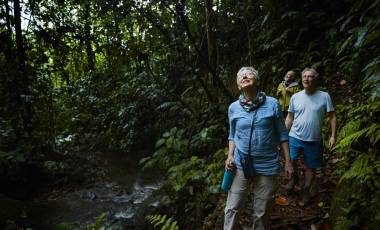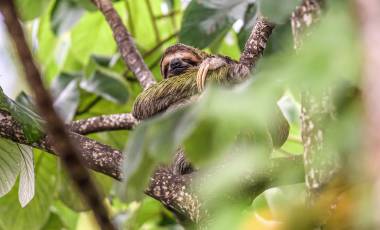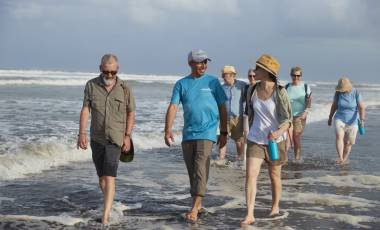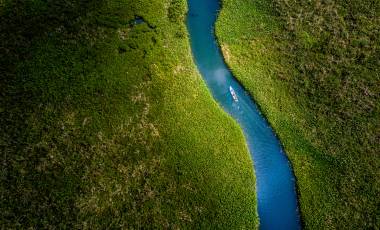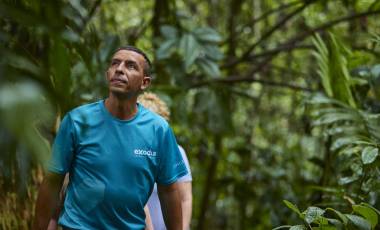Everywhere you go, Costa Rica is brimming with wildlife, but we seek out the best spots where you’ll most likely come face-to-face with some of the country’s most impressive creatures. Tortuguero National Park is undoubtedly one of the best places to visit on our Costa Rica wildlife holidays. The Park is made up of swamps and meandering waterways where you’ll discover hundreds of species of birds, monkeys, butterflies, iguanas, caiman and the famous Costa Rica turtles, including the Hawksbill, Loggerhead, Green turtle and Giant Leatherback.
On our Costa Rica wildlife tours, you’ll explore various rainforests which are buzzing with fascinating creatures such as toucans, monkeys, sloths, possums and coatis. In particular, Monteverde is a great place to experience animal encounters on our Costa Rica wildlife holidays. But if it’s marine animals you’re looking for, then head to Manuel Antonio National Park where the marine reserve plays host to dolphins, whales and turtles as well as land mammals such as white-faced capuchin monkeys, mantled howlers and three-toed sloths.
On our Costa Rica wildlife tours, we take you right to the heart of the action with guided walking tours along trails through the rainforests and boat trips down rivers and canals. You can also sail out onto the ocean to spot dolphins and whales in their natural habitat. The slow pace of the tours means you have a greater chance of meeting the local wildlife and watching them interact in their own environments.
Well, where do we start? With over 500,000 different animal species occupying this beautiful country, there are far too many to list them all. But some of the most iconic you could see on our Costa Rica wildlife holidays include:
Scarlet macaws
Frogs
Iguanas
Various species of turtles
Sloths
Monkeys
Coatis
Dolphins and whales
Caiman
Armadillos
Porcupines
Possums
While they might not resemble the big grizzly or brown bears you’re most likely imagining, there are several small bears that can be found in Costa Rica, and these include the coati, kinkajou, slender bear, sloth and raccoon. Mostly inhabiting the jungles and hiding in trees, you might be lucky enough to spot one of these species, however, the racoon and coati are most commonly seen.
Depending on what you want to see will determine the best time to visit Costa Rica. Although the temperatures are moderate throughout much of the year, the tropical climate does mean that you should always expect and prepare for some rain. Between December and April is the dry season and is a great time for viewing Costa Rica wildlife, however, these months do tend to attract the tourist crowds. In between the downpours during May and November, there is also lots of sunshine, which makes lush conditions for exploring the national parks.
The best place to see turtles in Costa Rica is undoubtedly at Tortuguero National Park, along the North Caribbean Coast. There are four species of turtles that can be found here, including the green sea turtle, the leatherback turtle, the loggerhead turtle and the hawksbill turtle. The beaches of Tortuguero National Park provide nesting sites for the turtles, with Tortuguero Beach being the largest. The best times to see green turtles here is from July to mid-October and you’ll most likely spot leatherbacks between February and June.
With humpback whales occupying the waters along the Pacific Coast for approximately eight months of the year, Costa Rica boasts one of the world’s longest whale watching seasons. The best months for Costa Rica wildlife tours that include whale watching are January to February and August to September. This is when these majestic mammals start to breed, meaning they are much more active. Humpback whales are most often spotted from August to October and December to April. You might also get to see other species such as sperm whales, killer whales and pilot whales.
Wedged between the San Carlos plains and the foothills of Cordillera de Tilaran in northwest Costa Rica, Arenal National Park plays host to the dormant Chato Volcano and the country’s largest and most active volcano, Arenal. You’ll also find the largest lake here, Lake Arenal, which lies beneath the volcano and is surrounded by tropical rainforest teeming with wildlife. While exploring the national park, you’re most likely to spot white-faced monkeys, howler monkeys, deer, parrots and tapir. Formed by Arenal’s devastating eruption in 1968, lava rocks and lava fields make up many of the trails that wind through the park.

